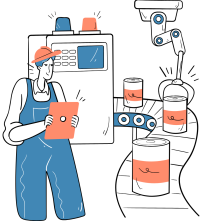Driving productivity and efficiency through employee-centred process design
At a major food manufacturing client with $149M+ in assets, operational processes across Finance, Planning, Production, and Procurement were evaluated to improve data driven decision making and employee efficiency. By mapping end-to-end processes, identifying pain points, and designing initial future-state workflows, actionable recommendations were delivered, including opportunities for ERP adoption.
The initiative projected a 50% boost in productivity, 30% faster process completion, and laid the groundwork for enhanced cross-department collaboration and a more streamlined employee experience.
Project Manager & Process Analyst
2020 / 2021

Despite being one of the largest food manufacturing organisations in the Caribbean, this company faced operational inefficiencies that hindered data driven decision-making, slowed employee productivity, and limited overall performance. The key challenges included:
Complex and manual workflows
-
Many processes were highly manual, involving large volumes of paper, multiple steps, and redundant approvals.
These inefficiencies caused delays, increased the likelihood of errors, and slowed day-to-day operations, limiting the organisation’s ability to make timely, data-driven decisions.
Lack of system integration
-
Existing systems were fragmented and did not fully communicate with each other, preventing seamless data flow across departments.
This also limited the organisation’s ability to leverage real-time information for performance tracking, reporting, and operational insights.
Limited automation opportunities
- The absence of integrated digital tools constrained the ability to automate repetitive tasks, scale operations efficiently, and free employees to focus on higher-value work.

Addressing these challenges was critical not only for improving efficiency and productivity, but also to enable data-driven decision-making, enhancing the employee experience, and aligning operations across functional areas.
By targeting the root causes of workflow and system inefficiencies, the project aimed to create processes that were standardized, streamlined, and optimized for both people and operations.
The project focused on understanding operational workflows, uncovering inefficiencies, and designing future-state processes to improve productivity, standardization, and enabling data-driven decision-making.
The approach combined human-centred analysis, process mapping, and systems evaluation and included the following:
Tools & Methods Used:
BPMN, Workshops, Process Mapping, Benchmarking,
Employee-Centred Analysis, System Assessment

Current State Process Mapping
Mapped 20+ end-to-end workflows across Finance, Planning, Production, and Procurement using BPMN. Captured all steps, handoffs, and system interactions to identify bottlenecks, redundancies, and delays affecting operational efficiency.

Employee Centred Pain Point Analysis
Conducted interviews and walkthroughs with process owners and stakeholders to understand workflow challenges from the employee perspective. Focus was on areas where manual effort, repetitive tasks, or system gaps hindered productivity and data accessibility.

Systems and Integration Assessment
Evaluated existing IT systems and their ability to communicate and share data across departments. Identified gaps preventing seamless information flow for reporting, automation, and data-driven insights.

Future-State Workflow Design
Developed initial redesigned workflows aimed at reducing manual effort, minimising bottlenecks, and improving standardization. Emphasis was placed on ensuring the workflows could leverage system(s) capabilities and provide better visibility for data-driven decision-making.

Impact Projection & Recommendations
Estimated potential productivity gains and process completion improvements. Recommended ERP adoption and system enhancements to unify operations, enable automation, and improve access to operational data across departments.
By redesigning workflows and evaluating system integration, the team projected measurable improvements across operational efficiency, employee experience, and readiness for future automation:

Projected 50% increase in productivity
Streamlining workflows removes redundant steps, reduces manual paperwork, and optimises high-volume tasks.
Employees across Finance, Planning, Production, and Procurement could focus on higher-value work, boosting efficiency and reducing frustration.

Projected 30% faster completion of key processes
Reducing handoffs and adopting technologies such as IoTs allow tasks to move more smoothly between teams.
Core processes, such as procurement approvals and production planning, could be completed faster, creating more predictable timelines and enabling better operational planning.

Actionable ERP adoption roadmap
Evaluations of system gaps and workflow inefficiencies informed clear recommendations for ERP adoption.
By integrating disparate systems, automating repetitive tasks, and improving data accessibility, the organisation can position itself to make more data-driven decisions and scale operations effectively.

Enhanced alignment across departments
Future-state workflows standardized processes, helping employees and stakeholders work consistently and collaboratively.
Teams could gain visibility into responsibilities and dependencies, reducing duplicated efforts and establishing a foundation for smoother adoption of integrated systems and operational improvements.